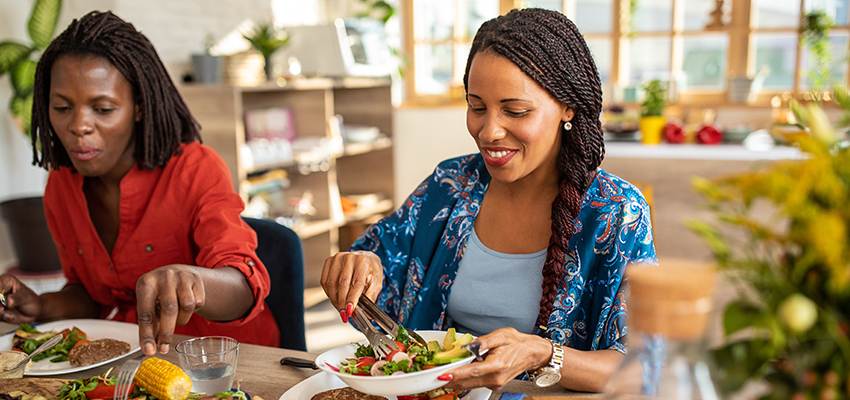Josephine Connolly-Schoonen, PhD, RD, Executive Director of the Nutrition Division at Stony Brook Medicine, is joined by Registered Dietitians Sotiria Everett, EdD, RD and Leah Holbrook, MS, RD for a discussion about nutrition and healthy eating. The team answers common questions about nutrition, and helps listeners to develop a framework for healthy meals and snacks that will meet their nutritional needs.
What You’ll Hear in This Episode
- 00:01: Opening and Introductions
- 01:00: The Healthiest Style of Eating
- 02:48: Meal Timing
- 04:00: What to Eat Before and After Workouts
- 06:20: How Much Protein Do You Need?
- 08:45: Guidelines for Alcohol Consumption
- 10:45: Do You Need to Take Supplements?
- 14:05: Healthy Snacks
- 15:05: Nutrient Needs for Women
- 17:00: Closing Remarks About Healthy Eating
Full Transcript
Welcome to HEALTH, Yeah!, where experts from Stony Brook Medicine come together to discuss topics ranging from the complex inner workings of an infectious disease to tips and tricks for staying safe and healthy all year long.
Continue Reading…
Josephine Connolly-Schoonen, PhD, RD 0:17
Welcome. I’m Dr Josephine Connelly Schoonen and I’m the director of the Nutrition Division here at Stony Brook Medicine, and I have two of our Registered Dietitian Nutritionists on faculty with me here to discuss nutrition with you today. So first I have Dr Sotiria Everett, if you can introduce yourself, please.
Sotiria Everett, EdD, RD 0:34
Hi everybody. I’m Sotiria Everett, Clinical Assistant Professor in the Nutrition Division at Stony Brook Medicine.
Josephine Connolly-Schoonen, PhD, RD 0:41
And we also have Ms Leah Holbrook.
Leah Holbrook, MS, RD
Hi, I’m Leah Holbrook. I’m a registered dietitian and Associate Director for the graduate nutrition programs here at Stony Brook.
01:00: The Healthiest Style of Eating
Josephine Connolly-Schoonen, PhD, RD
Welcome. I’m looking forward to our conversation today. So we all know that there is mountains of nutrition information out there that’s so readily accessible, some of it is factual, some of it’s not, and a lot of it is a mix, a little tidbit of factual information and a lot of fluff. So we’re here today to help you develop an informational framework and empower you to sort through that information. So the evidence supports, kind of to set the table, that a whole food minimally processed, plant-based style of eating is by far the healthiest for the general public. And that doesn’t mean you have to be a vegetarian. You could sprinkle in minimally processed whole animal foods like chicken and fish. So we want our plate to have primarily plant foods, vegetables, grains and starches, starchy vegetables, beans, peas and lentils, and then fish, chicken as you like. This is often referred to as the Mediterranean diet. But there are other ethnic, traditional styles of eating that kind of fit that general parameter as well. It gets a little tricky when we read on social media and on the internet about diets that eliminate either nutrients like carbs or protein, or fat or specific foods like gluten or dairy.
So there’s flexibility, right? We could vary the carbs, the protein and the fat. People can get into a little trouble if they go to the extreme, like if we reduce carbs so much that we’re more in the Keto style and then using processed Keto branded products, right? Same thing with protein. Some people may want to try a little extra protein, but not the protein bars and the protein powders. So we’ll delve into all this a little bit more. So that’s general information about quality and Ms Holbrook, if you can help us now, just discuss timing, when should we eat and how often should we eat? What would you recommend?
02:48: Meal Timing
Leah Holbrook, MS, RD
Sure, intuitive eating is a really popular buzzword. It incorporates a lot of different principles, but at its core, it really is talking about feeling hunger and fullness. So infants are largely born with the innate ability to sort of manage their intake through hunger and fullness cues. But as we grow, factors such as environmental cues, social cues and even frankly, pressure from others can mess with that intuitive sensation and prompt us to kind of get off course. So for many people, they need to relearn intuitive eating practices in order to best moderate their food intake, but also to manage their eating schedule or meal times. So intuitive eating is one evidence-based way of approaching meal times, and I think in terms of how many meals an individual should eat per day, there’s no one magic number. Again, a lot of this is individualization, but a minimum of two meals per day is likely a good place to start for most people.
Josephine Connolly-Schoonen, PhD, RD 3:53
Okay, now we also encourage people to exercise. So Dr Everett, for those that are active, can you provide guidance on what people should eat before and after a workout.
04:00: What to Eat Before and After Workouts
Sotiria Everett, EdD, RD
Yes, and you know, we all like to encourage exercise. A lot of that is to help with weight management. So I do want to remind you that when you focus your eating around your exercise, you also have to remember the big picture and what you eat throughout the day to help support a healthy weight. But in general, a general rule of thumb is, the closer you get to a workout, the smaller the meal should be, or a light snack, because you do want that energy to support your workout. If you eat something high in carbohydrates, a little bit of protein, you get that energy for that workout. So it’s a better workout. You perform better and you have that endurance to sustain your exercise. I think the best example that I could give is a lot of us work, and then we go to the gym after work. Sometime after work, we may eat lunch around 12 o’clock, 1 o’clock, so it would be a good idea maybe a couple hours before the gym, to have a light snack, yogurt, granola, some fruit. It’s going to provide energy, protein, carbohydrates to help you make it to the gym so you’re not too tired for that workout, and then after your workout, a reasonable dinner, lean protein, whole grains, carbohydrates, nutrient dense vegetables, that should help you with that recovery process, to build the lean muscle that you look for. But you know, you’re at the gym and there’s all these protein shakes that are targeting recovery post workout. You know, are they needed?
The goal of exercise for weight management is to help mobilize your stored fat; that stored fat burns to produce some of the energy during the workout. If you go for that protein recovery shake or that nutrition bar at the gym, it blunts that effect, so it might defeat the purpose of the workout. If a person wants to exercise and goes to the gym, a meal at a reasonable time after that will be sufficient. I would say that’s the goal, not a nutrition shake at the gym.
Josephine Connolly-Schoonen, PhD, RD 6:05
Yeah, and I’m going to remind us about that minimally processed whole food, right? So think about those protein powders and bars. They don’t look like they were growing on a vine. All right. So when we talk about exercise and working out and building muscle, I think of protein. There’s so much information floating around about protein. So for those that maybe aren’t working out, or other people, maybe, as we get older, can you make any recommendations about the amount of protein people need?
06:20: How Much Protein Do You Need?
Sotiria Everett, EdD, RD
Yeah, there’s a lot of focus on protein these days. I go to the supermarket, I see protein right there on the label of a food. So there’s a huge emphasis. But how much do we need? Well, you know that varies, as you mentioned, Dr Schoonen, because if you’re older, adults might need a little bit more. Active individuals might need a bit more, but in general, I would say .8 to 1.2 grams per kilo. So as healthcare providers, we use that metric system. But what does that mean for someone who’s about 150 pounds, that .8 to 1.2 grams per kilo is actually about 50 to 80 grams of protein. And whole foods do support that optimal diet pattern that we’re recommending. And you could get those 50 to 80 grams of protein by eating regular common foods: chicken, red meat, eggs, dairy, if you want to have obviously we’re encouraging more plant-based foods, so beans, nuts, dairy products so you could get enough protein, you do not need a protein supplement. Most of us overeat protein anyway, so those supplements are not recommended or needed.
And then one thing that’s even more important than how much you should get total in a day is that even distribution of protein throughout the day that helps with maintaining lean body mass, like muscle and helps with appetite regulation. So beyond thinking total protein for the day, make sure that you spread it out throughout the day, a bowl of oatmeal, believe it or not, has five grams of protein. You could boost the protein and oatmeal by cooking it with some milk or soy milk, and add a little bit of peanut butter. That could become a 20 gram protein breakfast, lunch and dinner. Just to illustrate, you know, a cell phone is would if you were to compare portion sizes, the piece of chicken the size of a cell phone, that gives you almost 30 grams of protein. So if you have something like that at lunch and dinner, you could space out those 20-30 grams of protein and meet your daily needs, help with appetite and muscle maintenance.
Josephine Connolly-Schoonen, PhD, RD 8:35
Yeah, good point. It’s very easy to accumulate enough protein. Well, it’s also very easy to accumulate alcohol. So we may want to switch gears a bit. People are asking a lot about alcohol recommendations, or how much alcohol is too much, and guidelines have changed a little bit, I believe. So. Ms Holbrook, Can you fill us in on your guidelines for alcohol consumption?
08:45: Guidelines for Alcohol Consumption
Leah Holbrook, MS, RD
Sure, sure. So the evidence on alcohol consumption is evolving, and constantly we have new information about the impacts of alcohol and health. So the published recommendations from most health agencies remains roughly the same, which is one drink per day for women and two drinks per day for men. Now it’s important to note, those are not recommendations. They’re not encouraging that amount. What they’re saying is that for those who choose to drink alcohol, that would be the maximum per day, which obviously would equate to seven drinks per week for women and 14 for men. But newer research really is supporting the idea that any alcohol consumption carries some health risk, and that even less than the maximum or none at all is the best way to optimize health. So we have to take that into account and make a reasonable choice, keeping these guidelines in mind and recognizing that alcohol does carry some health risks.
On top of that, you know, not only are many people looking to reduce calorie intake, they’re also looking to reduce sugar intake. And many people do not consider the sugar that is in many popular drinks. If you take, for example, a popular, you know, common drink, someone might order a margarita that is roughly 36 grams of sugar, which is seven teaspoons, or otherwise, seven packets of sugar. And I think many people would hesitate to put seven packets of sugar in their morning coffee, but may not think twice about ordering a cocktail or two when they’re dining out. So we want to keep that in mind too, not only about the health risks associated specifically with the alcohol consumption, but the impact alcoholic drinks have on our overall dietary choices.
Josephine Connolly-Schoonen, PhD, RD 10:39
Yeah, good point. Okay, so another big topic that people are curious about is our supplements, vitamin and mineral supplements. So Dr Everett, any guidelines or suggestions about whether people need to take supplements? What should we be thinking?
10:45: Do You Need to Take Supplements?
Sotiria Everett, EdD, RD
Yeah, that’s a big one. People are concerned maybe they’re not getting enough vitamin C from their diet, or iron or calcium. But back to those fundamental recommendations of low unprocessed foods, whole foods, fruits, vegetables, plant based foods, they are the best source of micronutrients. So you could look at a high quality multivitamin to kind of cover what you need, but that shouldn’t be the primary strategy of getting your essential nutrition. It should be a food-first approach, like we are recommending. The only one I could think of that’s a little bit difficult to get from your diet is vitamin D. And many go to their healthcare providers and ask, you know, can you check my vitamin D? Am I deficient? And a supplement might be needed in that situation, but more isn’t better. So if you do look into taking supplements, be aware of how much is in that supplement. You don’t want to overdo it and monitor that supplement and talk to your healthcare provider. It should be a discussion.
Josephine Connolly-Schoonen, PhD, RD 12:00
Yeah, sometimes people will start a vitamin D and never get their values checked again. They started it because they were low and they never reevaluate. So that is important.
Sotiria Everett, EdD, RD 12:07
Yeah, and there’s various doses that they could get, and high doses over time can lead to some unintended consequences.
Josephine Connolly-Schoonen, PhD, RD 12:15
Yeah, another type of supplement, if you could add on, would be pre and probiotics, right?
Sotiria Everett, EdD, RD 12:20
Pre and probiotics. That’s also in the highlight of optimal health, we want to have what’s called a healthy microbiome, that ecosystem in our digestive system. That ecosystem has live bacteria that support our health, that supports our immune health, digestive health, and beyond that, there’s a lot of discussion of setting up a diverse and healthy microbiome just to stay healthy. And probiotics, you could get them in a supplemental form. Some of those supplements have only a few strains of probiotics, and remember, the goal is diversity, have a variety of bacteria in there to help with your health.
So ways to support that diversity may not be a probiotic, just because it might be a concentrated strain, but you can also affect that diversity by eating fermented foods. Think about yogurt, kefir, sauerkraut, all these foods that are fermented, that are natural sources of probiotics. And once you have that variety of probiotics in your gut, you want to support their growth, their activity, and that’s where prebiotics come into play. Fiber is food for your gut bacteria. So the more fiber you get, and we under eat fiber too. So that’s one thing to keep in mind. We overeat protein and under-eat fiber. Plant-based foods can help you get to that, beans, fruits, vegetables and prebiotics from fiber will help our gut bacteria thrive and will support overall health.
14:05: Healthy Snacks
Josephine Connolly-Schoonen, PhD, RD
Yeah. So a way to think about getting all of our nutrients in is through healthy snacks, right? So the items you had just mentioned can be combined into snacks, right? So we should be thinking about snacks as a way to kind of boost those nutrients. So fruit and nuts, yogurt and fruit or nuts, yeah, is a good way to meet our nutrient needs. Speaking of healthy snacks. Why don’t we share our favorite healthy snack? Dr Everett?
Sotiria Everett, EdD, RD 14:23
Yes, I mean, the example that I used about exercise and getting a healthy snack before it’s actually kind of what I go by. I am a big fan of Greek yogurt, plain, not flavored. If you flavor it, there’s added sugar. I love using blueberries with Greek yogurt and a little bit of a sprinkle of granola on top, just for that crunch.
Josephine Connolly-Schoonen, PhD, RD 14:43
And Ms Holbrook?
Leah Holbrook, MS, RD 14:45
It’s hard to choose, but I think I’m going to go with a sliced apple with a little bit of crunchy almond butter.
Josephine Connolly-Schoonen, PhD, RD 14:52
Oh, nice. I’m going to go with plain oatmeal. You could do instant plain oatmeal with almond butter. So that’s one of my favorites. So in terms of nutrient needs, women have some special considerations because of reproductive health issues and changes in our reproductive years. Any special requirements of things that women should be thinking of?
15:05: Nutrient Needs for Women
Leah Holbrook, MS, RD
Yeah, sure. So starting off with pregnancy, which is what a lot of us think of as a time of a lot of nutritional change. And it’s very true, pregnancy is a high demand time for nutrients. So starting off with that, we want to certainly recommend women consider a high quality prenatal vitamin during pregnancy beyond the reproductive years, though, the needs don’t stop. So beyond reproductive years, women in perimenopause or menopause, their hormonal shifts are much more drastic than men of a similar age, and that drop in estrogen can really slow, prompt a slowing of their metabolic rate, which leads to a reduction in calorie needs. So even if a woman is not changing her eating habits, she’s eating the same number of calories that she was, she may notice a susceptibility to weight gain. And I think a lot of women come to us saying just that.
So what we need to keep in mind here is that we need to do two things really. We need to emphasize a nutrient dense diet, but not a calorically dense diet. So a lot of nutrient dense foods, much like we’re discussing, whole foods, especially plant-based, because produce is just so high in micronutrients and so following that, so you’re getting all the nutrients you need without a lot of excessive calories. And the second component, which is equally as important, is either starting or maintaining an exercise program that emphasizes strength training, because strength training will preserve lean body mass, which is so key to weight control as well as bone health and that will go a long ways in terms of helping to keep yourself healthy, both from a weight perspective as well as a nutritional perspective.
17:00: Closing Remarks About Healthy Eating
Josephine Connolly-Schoonen, PhD, RD
Yeah, so I don’t want to overwhelm people. We discussed so many really interesting topics. So I think we can leave people with the idea that you want to shift your eating habits. No one should think that they have to make dramatic changes overnight, but you want to shift towards a least processed, whole food diet, and working out and getting your exercise in right, getting our fiber and micronutrients, also in terms of gut health, being out in nature, it is also helpful to populate our gut microbiome. So in terms of if you have special nutrient needs, if you are struggling with a medical condition or trying to avoid a medical condition that you might have a family history for, then you might want to seek the guidance of a registered dietitian to really help you tweak our recommendations in a way that would be appropriate for you, and to help you delay illness, delay progression of illness, and really live and age in a way that you feel good and can optimize your health. That’s what nutrition is all about. Well, thank you again for your time. Ms Holbrook and Dr Everett, this was a fabulous conversation, and we thank our viewers and our listeners today for joining us and tuning in and for your interest in nutrition and your overall health. So if you feel like you need a little bit more structure or a little bit more individualized nutrition advice, you can Google Stony Brook Nutrition Therapy, and you will find us, and we are happy to work with people individually and really help you meet your nutrition needs and goals.
Announcer 18:25
Stony Brook Medicine is Long Island’s premier academic medical center. We transform lives through scientific discovery, education and care, and we bring together innovative research, advanced education and extraordinary healthcare expertise to set the standard for how healthy communities thrive. For more information, visit stonybrookmedicine.edu or follow us on social media, Stony Brook medicine on Instagram, Threads, Facebook, YouTube and LinkedIn and Stony Brook Med on X.














